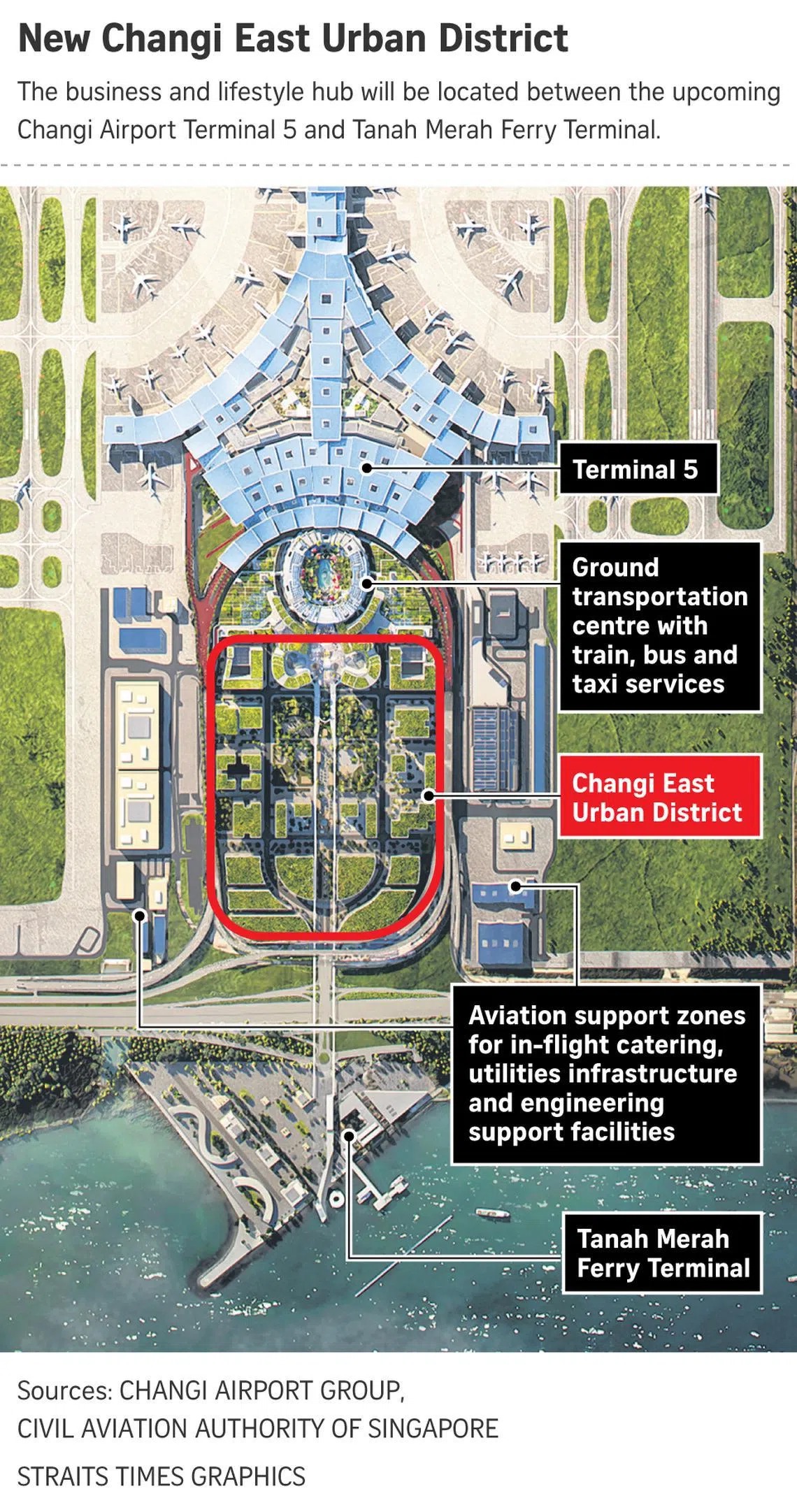Proposals sought to develop Changi East Urban District next to T5
[SINGAPORE] The authorities are calling for proposals to sketch out the concept for the new Changi East Urban District next to Changi Airport Terminal 5 (T5), in the first step towards developing the future business and lifestyle hub.
Part of the new Changi East development, the district will occupy a 40 ha tract of land – about the size of 56 football fields – between the upcoming T5 and Tanah Merah Ferry Terminal.
The district is meant to be a destination that appeals to both international visitors and Singapore residents, based on tender documents by the Ministry of Transport (MOT) and the Civil Aviation Authority of Singapore (CAAS) published on government procurement portal GeBiz on Aug 13.
It will strengthen the Changi air hub and complement developments at the airport and in the surrounding Changi region, said the authorities.
When ready in the mid-2030s, T5 will allow the airport to serve 140 million passengers yearly, over 55 per cent more than its present capacity of 90 million.
The authorities said the Changi East Urban District will strengthen the Changi air hub, as well as complement developments at the airport and in the surrounding Changi region.
BT in your inbox
Start and end each day with the latest news stories and analyses delivered straight to your inbox.
Noting that the district will be located near a potential waterfront district to the south of Changi, the authorities said it should reap synergies with the region while distinguishing itself from other places in Singapore.
The Changi East Urban District “should be a destination unto itself” while “integrating work and play”, they added.
In their call for proposals, MOT and CAAS invited multi-disciplinary teams to carry out a demand study and concept planning for the district.
Phua Chai Teck, director of airport development and planning at CAAS, said the study will inform the government’s vision and plans for the district.
The appointed consultant will work with both MOT and CAAS to conduct the study and develop a concept plan.
Other agencies – such as the Urban Redevelopment Authority – and stakeholders will be consulted, said Phua.
Stage one of this tender will close on Sep 24, with the final tender to be awarded around mid-2026.
The second stage of the tender entails drawing up a detailed concept plan for the Changi East Urban District, which the authorities said must encourage community building in public spaces, as well as convey a clear sense of identity and belonging.
The concept plan has to factor in transport connectivity and propose car-lite measures, on top of green corridors and public spaces.
It should make the most of underground spaces – where feasible – and align the district with the national sustainability goal of achieving net-zero carbon emissions by 2050.
The appointed consultant will also have to submit a demand study to forecast demand for the district up to the mid-2050s, and analyse long-term user trends based on wider socio-economic and travel patterns.

Another requirement is a financial study detailing the benefits and financial feasibility of each development there.
Professor Lam Khee Poh, provost’s chair professor of architecture and the built environment at the College of Design and Engineering at the National University of Singapore, suggested that the district can differentiate itself from the Changi region by functioning as a development with net-zero carbon emissions.
This could entail having a renewable energy distribution hub, buildings that generate more renewable energy than what they consume, and adopting automated processes powered by artificial intelligence for more efficient energy consumption, he added.
On attracting visitors, Prof Lam said the new district should feature a “stress-free” experience, given that travel can be stressful.
He proposed a mix of “highly active places” with options to detour easily and quickly to some quieter outdoor areas that can offer “natural respite”, which wellness businesses can support.
Professor Cheong Koon Hean, chair of the Lee Kuan Yew Centre for Innovative Cities at the Singapore University of Technology and Design (SUTD), said the district’s unique location lends itself to demand from business and leisure travellers due to its proximity to the airport and the waterfront.
It could draw from its surrounding infrastructure and activities – such as Changi Business Park, SUTD, Changi General Hospital and the Singapore Expo convention centre – to be unique and attractive.
Highlighting that the Changi Point area is known to be idyllic, Prof Cheong said the district could leverage its laid-back and rustic character with beaches, mangrove boardwalks and built heritage through recreational opportunities.
She suggested enhancing the demand by setting up an aviation business campus, offices to serve firms that want easy airport access, exhibition centres to host business events or exhibitions, and premium transit hotels or resorts for short-stay passengers who want to be near the airport.
Prof Cheong noted that nature and wellness activities can take place there, with beachfront living residences or hotels, seafront walks with cycling trails and links to mangrove boardwalks, as well as wellness-themed resorts that could encourage medical tourism at the nearby Changi General Hospital.
The district can also focus on experiential retail, she added, with themed retail stores, dining options and integrated cultural venues for arts activities.
“The unique waterfront location does offer some opportunities for not only retail, but combined with lifestyle and play can be marketed as a weekend or short-trip attraction, which appeals to both tourists and locals,” she said. THE STRAITS TIMES

